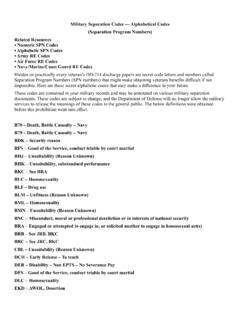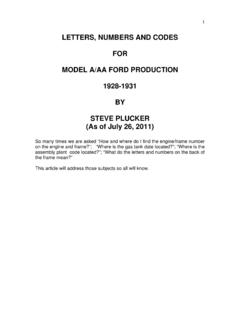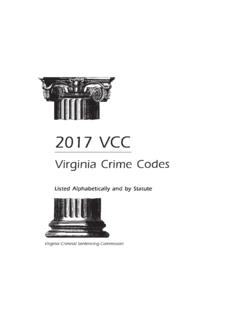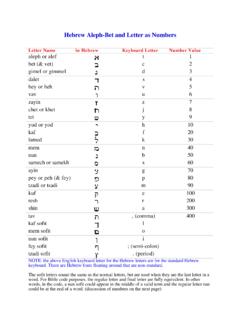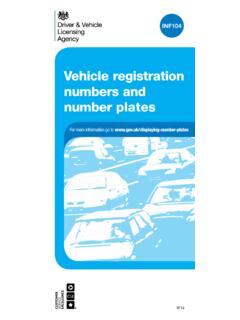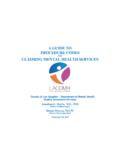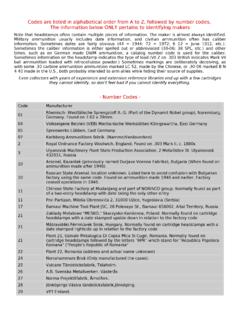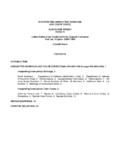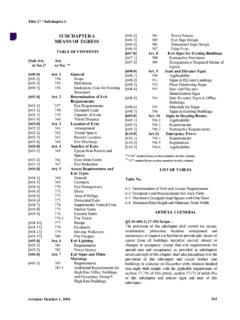Transcription of CAR REGISTRATION AND NUMBER PLATES 1903 to 2003
1 CAR REGISTRATIONAND NUMBER PLATES1903 to 2003 This information has been compiled for the CVPG from details supplied by the Driver and VehicleLicensing Agency, Swansea and is believed to be accurate. Despite this, however, the author andCVPG cannot accept any responsibility for any complaints or problems caused by reliance on theinformation contained in this October 20031 OR 2 LETTER PLATESONE OR TWO LETTERS FOLLOWED BY ONE TO FOUR NUMBERS OR REVERSET hese PLATES are rare and are normally only seen on newer vehicles as cherished or personalised numbers. However, some still existand were originally issued to vehicles first registered between 1903 and the mid 1930's. The reverse (where the one or two lettersfollow the numbers) are very rare - only a few of these were issued in the 1950's / 60's when three letter plate combinations ran one or two letters, in the above example AB, make up the 'area identifier' and indicate where the vehicle was first identifiers for vehicles first registered from 1 September 2001 are different to those used with this the plate is reversed, 1234AB, the two letters (AB) are still the area numbers, in the above example 1234 are the individual element which give the vehicle it's unique identity.
2 The numbers areissued in sequence from 1 to 9999. Not all possible combinations of these PLATES were issued - and many have since been sold on ascherished this series of PLATES has long since ceased being issued to new vehicles, it is still in use for re-registrations for pre-1931('vintage') vehicles which need new PLATES . The current series being used for re-registrations is SV8000 - SV9999 which was neveroriginally LETTER PLATES BEFORE 1963 THREE LETTERS, ONE TO THREE NUMBERS OR REVERSEOn cars first registered before 1963 (or 1965 in some cases), NUMBER PLATES look like this. The PLATES usually carry the three lettersbefore the numbers between 1 and 999, but some are reversed with the numbers preceding the the group of three letters, the second and third letter, in the above example BC, make up the 'area identifier' and indicate wherethe vehicle was first registered.
3 Area identifiers for vehicles first registered from 1 September 2001 are different to those used withthis the plate is reversed, 123 ABC, the second two letters (BC) are still the area first letter and numbers, in the above example A__ 123 are the individual element which give the vehicle it's unique numbers are issued in sequence from 1 to 999. The letter (called the serial letter) is issued in sequence, usually when all pos-sible numbers have been used up, so ABC1 would be followed by ABC2, up to ABC999 when the next issue would be all possible combinations of these PLATES were issued - and many have since been sold on as cherished numbers. Reversedplates follow the same format, so 999 ABC would be followed by 1 BBC then 2 BBC this series of PLATES ceased being issued to new vehicles between 1963 and 1965, it is still in use for re-registrations - thatis, older vehicles which need new PLATES .
4 The current series being used for re-registrations is ASL100 - YSL999 which was neveroriginally 1963 - 1983 (YEAR SUFFIX)THREE LETTERS, ONE TO THREE NUMBERS, ONE LETTERThis is the format of REGISTRATION used on vehicles first registered between 1963 and second two letters, in the above example BC, are the 'area identifier' and indicate where the vehicle was first registered. Areaidentifiers for vehicles first registered from 1 September 2001 are different to those used with this last letter, in the above example A, is the 'age identifier' or 'year letter' and shows the date when the vehicle was first registered- in this case during 1963. Year letters were not compulsory until 1965, so a vehicle may have been registered during 1963 and1964 without a year first letter and numbers, in the above example A__ 123 are the individual element which give the vehicle it's unique numbers are issued in sequence from 1 to 999.
5 The letter (called the serial letter) is issued in sequence, usually when all possiblenumbers have been used up, so ABC1A would be followed by ABC2A, up to ABC999A when the next issue would be , prior to 1974, the change in year letter did not affect the plate sequence so ABC123G would be followed by ABC124G orABC124H depending on which year letter applied at the time. After 1974 the serial letter and numbers usually 'reset' with the changeof year letter so if Hxx923N was the last plate issued in a series for the "N" suffix period, it would be followed by Jxx1P. This wasnot always the case, however, and for REGISTRATION offices with many area codes, every area code combination with the same serialletter would be used before the serial letter this series of PLATES ceased being issued to new vehicles in 1983, it is still in use for re-registrations - that is, older vehicleswhich need new 1983 - 2001 (YEAR PREFIX)
6 ONE LETTER, ONE TO THREE NUMBERS, THREE LETTERSThis is the REGISTRATION system used prior to the current one and most of the vehicles on Britain's roads today display a plate of first letter, in the above example A, is the 'age identifier' or 'year letter' and shows the date when the vehicle was first registered- in this case between 1 August 1983 and 31 July last two letters, in the above example BC, are the 'area identifier' and indicate where the vehicle was first registered. Areaidentifiers for newer vehicles are different to those used with this numbers and second letter, in the above example 123 A, are the individual element which give the vehicle it's unique numbers are issued in sequence from 21 to 998, with some being witheld for select (personalised NUMBER plate ) use only. Thesecond letter (called the serial letter) is issued in sequence, usually when all possible numbers and area codes (if an office has morethan one) have been used up.
7 On 1 August 1996, for example, new vehicles in NW London were issued PLATES from P21 LLA. Whenthe series had reached P998 LLA the next REGISTRATION to be issued was P21 LLB - the next NW London area code - until all possibleNW London area codes were used and the series returned to LA with the serial letter advancing, P21 MLA. On 1 August 1997, the"P" age identifier was replaced with the "R" age identifier but not all possible serial letters had been used - the LA series had this series of PLATES ceased being issued to new vehicles in September 2001, it is still in use for re-registrations - that is,older vehicles which need new FROM 1 SEPTEMBER 2001 TWO LETTERS, TWO NUMBERS, THREE LETTERSThis is the current vehicle REGISTRATION system used in the UK, used on vehicles first registered from 1 September first two letters, in the above example AB, are the 'area identifier' and indicate where the vehicle was registered - the first letter"A" represents the general area (in this case Anglia) and the second letter "B" represents the town or city in this area where thevehicle was registered (not where the owner lives or the vehicle may reside!)
8 The area identifiers used with the current system aredifferent to those used prior to two numbers, in the above example 51, are the 'age identifier' and indicate when the vehicle was first registered - in this casebetween 1 September 2001 and 28 February three letters, in the above example CDE, are the individual element which give the vehicle it's unique identity. The letters areissued roughly in sequence, but some combinations are banned because they are deemed to be offensive. Some are also witheld fromissue because they are reserved for select issues (personalised NUMBER PLATES ) - these are usually combinations or letters which spellnames or words. Some combinations in a sequence are also omitted to prevent dealers from reserving potential 'favourites' forcustomers without going through the 'select' (personalised) scheme. For the first time on the UK mainland, the letter Z is permitted,but only for the serial letters.
9 Area codes cannot contain the letter Z as they are used for Northern plate may carry the GB "Euro" symbol on the left hand side, any symbol displaying other than "GB" and / or other than the EU"stars" logo is not OF UK CAR REGISTRATIONThe UK car REGISTRATION system traces back to 1903. The Motor Car act which came into force on January 1st,1904 required all vehicles in the United Kingdom to be registered and carry numberplates. Originally Countyand Borough Councils were to issue the NUMBER PLATES - a system which was to last until 1974 - when theDepartment of Transport took over the task with it's specially equipped Vehicle REGISTRATION Offices (VROs).A1 - YY9999 : 1903 - 1930'sEach council was issued with one or more letter codes for registering vehicles. Originally both one and twoletter codes were issued as of 1903. A list of these codes and the areas they apply to can be found on the areaidentifier pages.
10 This original system, using the one or two letter area code and one to four numbers ( AA1- AA9999) soon ran out and by the 1930's a change was - YYY999 : 1930's - 1960'sIt was decided an extra serial letter was to be introduced prefixing the original area code . This could only beused with two letter area codes, as prefixing a one letter area code would duplicate a two letter code , so thesingle letter area codes became obsolete. Serial letters were first introduced around 1932 as order for the size of the PLATES to remain the same, a maximum of only three numbers ( AAA234,GRF823) was used with this system. This serial letter ran in rotation with the numbers, so in the exampleADE998, the "DE" is the area code (in this instance, Pembrokeshire County Council), and the A--998 runs insequence. The next NUMBER in the Pembrokshire series would be ADE999, followed by BDE1 (note that nozeroes prefix the NUMBER 1).
